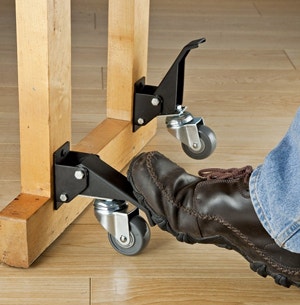How Best to Mobilize My Workbench?
My woodshop has limited space (in a dedicated one-car garage), and therefore all of my power tools are mounted on mobile bases. After a lot of research, I have decided to purchase a small SJOBERGS workbench rather than build one myself, for reasons that don't apply to this question. Given all the choices available, what is the best option for adding mobility to a solid workbench? The number of alternatives is almost overwhelming, and I would really appreciate some professional direction to narrow the field. Here are some of the selections I am facing:
- Wheel style: rolling, swivel casters
- Best wheel material for support, stability, wear: steel, rubber, neoprene, some other non-marking plastic?
- What kind of locking mechanism will maintain the best balance between flexible movement and stability? For example, when planing stock clamped between the end vise and a bench dog, I don't want the bench to be moving on caster swivels. That can happen even when the wheels are locked.
- Should I consider some form of wheel chocks?
- Wheel mounting options: fixed directly into the legs of the bench, attached to an angle-iron mounting bar, a rectangular dolly system like HTC, outrigger type swing-out, attached externally like a marine-type bolt-on jack that would allow the wheels to be raised out of the way, or suspended gate-type wheels that can be lowered using a spring press?
I'm sure there are other aspects to consider as well. Thanks in advance for your help. I imagine that others may benefit from your advice on this topic. - Steve Graham
Chris Marshall: Steve, I'm in the same boat as you, and my shop is bigger than a one-car garage. Working for the magazine, I'm constantly rearranging my shop for photo shoots, tool reviews and the like. So, I put a premium on rolling bases and casters. But, I haven't mounted my workbench on wheels yet. When I do (hopefully soon!), I'm going to use Rockler's Workbench Caster Kit. The urethane casters flip up or down on foot-activated steel lift mechanisms to let you either move the bench around or rest it solidly on its legs. For hand tool work, as you point out, you'll want the stability and mass of the bench standing off of its casters, so these seem a good solution in that regard. You wouldn't have to engineer your own wheeled fix. Bolt them on, and you'd be good to go. That's my advice.
Keep the inspiration coming!
Subscribe to our newsletter for more woodworking tips and tricks




